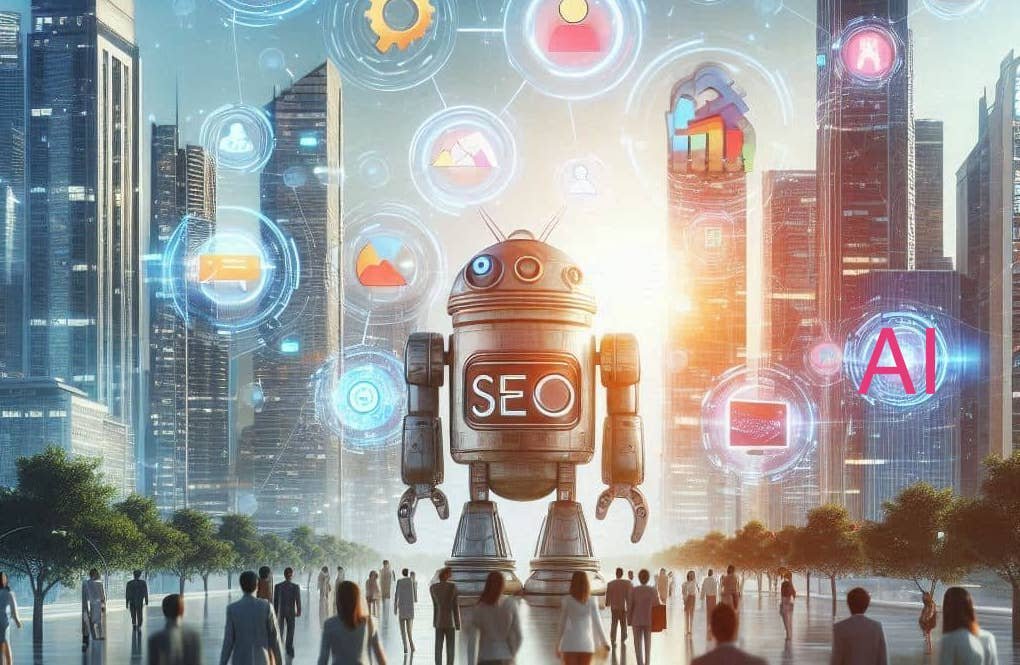Remember when Google was the go-to for all our burning questions? Well, folks, times are changing faster than you can say “Hey Siri!” With AI chatbots like ChatGPT making waves, we might be looking at a whole new ballgame for how we find information online. Let’s dive deep into what this could mean for SEO and how we might need to adapt our strategies in this brave new world of artificial intelligence.
Table of Contents
The New Kid on the Block: ChatGPT
So, what’s the big deal about ChatGPT? Unlike Google, which gives you a list of links to sift through (and let’s be honest, how often do we go past the first page?), ChatGPT can chat with you like a real person. It understands your questions and gives you direct answers. Pretty cool, right?
Imagine this: Instead of typing “best pizza near me” and clicking through various Yelp reviews and restaurant websites, you could ask ChatGPT, “Where can I get a great pepperoni pizza within walking distance that’s open right now?” And boom! You get a tailored response considering your location, the time, and your specific craving. No more opening ten tabs and comparing information – it’s all there in one conversational interface.
This convenience factor could be a game-changer. I mean, who wouldn’t want to skip the whole “open 10 tabs and skim through them” routine? It’s like having a super-smart friend who always knows the answer (and doesn’t get annoyed when you ask a million questions).
But here’s where it gets really interesting for us marketing folks and business owners: If people start relying more on AI chatbots for information, what does that mean for our websites and our carefully crafted SEO strategies?
SEO: Time for a Makeover?
If ChatGPT becomes the new Google, our SEO playbook might need some serious revisions. We’re talking major overhaul, not just a quick touch-up. Instead of obsessing over keywords and backlinks (though they’ll still have their place), we might need to focus on making our content super clear and easy for AI to understand.
Here’s what that might look like:
- Writing in a more conversational tone (kind of like I’m doing now!):
Imagine you’re explaining your product or service to a friend over coffee. That’s the vibe we’re going for. AI is getting better at understanding natural language, so we need to speak its language – which, ironically, is becoming more human. - Providing comprehensive answers to potential questions:
Instead of just focusing on one keyword, we need to think about all the questions someone might ask about our topic. For example, if you’re writing about running shoes, don’t just focus on “best running shoes.” Consider questions like “How do I choose running shoes for flat feet?” or “What’s the difference between trail running shoes and road running shoes?” - Using structured data to help AI understand our content better:
This is like giving AI a roadmap of our content. By using schema markup and other structured data formats, we’re essentially saying, “Hey AI, this is a product review,” or “This section is about pricing.” It helps AI chatbots quickly find and serve up the most relevant parts of our content. - Creating content clusters:
Instead of just creating standalone articles, we might need to focus on building comprehensive content hubs around topics. This gives AI a fuller picture of our expertise and allows it to pull information from multiple related pieces to answer complex queries. - Optimizing for featured snippets:
Even though we’re talking about a potential future where traditional search engines might be less dominant, optimizing for featured snippets is still a good practice. Why? Because the same clear, concise format that works well for featured snippets is likely to be easily understood and used by AI chatbots.
New Metrics for Success
Alright, so we’ve talked about how our content might need to change, but what about how we measure success? In the world of traditional SEO, we’re all about page views, click-through rates, and keyword rankings. But in a ChatGPT world, we might be looking at some very different metrics:
- AI comprehension rate:
How well does the AI understand and use our content? We might need new tools that can simulate AI interactions with our content and score how well it’s interpreted. - User feedback on AI-generated responses:
When ChatGPT or similar AI provides an answer based on our content, do users find it helpful? Are they asking for clarification, or are they satisfied with the response? This feedback loop could become crucial. - Engagement duration:
How long do users engage with the information provided by the AI? If users are quickly asking for different information, it might indicate that our content isn’t hitting the mark. - Content accuracy score:
As AI will be interpreting and potentially rephrasing our content, ensuring accuracy will be crucial. We might see the emergence of tools that cross-reference AI-generated answers with sources to ensure information isn’t being misrepresented. - Conversation continuation rate:
Does our content inspire users to ask follow-up questions? This could indicate the depth and interest level of our content. - Brand mention frequency:
How often is our brand mentioned in relevant AI-generated responses? This could become a new form of “ranking.” - Content update frequency:
How often do we need to update our content to keep it relevant for AI interpretations? This could become a key factor in maintaining “authority” in an AI-driven world.
The Art of AI-Friendly Content
Now, I know what you might be thinking: “Creating content for AI? Sounds pretty robotic to me.” But here’s the twist – it’s all about being more human. Clear, informative, and engaging content is what will win the day. We’ll need to:
- Break down complex topics into digestible bits:
Think of it as creating a really good explainer video but in text form. How would you explain your topic to someone completely new to it? That’s the level of clarity we’re aiming for. - Use examples and analogies to illustrate points:
AI is getting better at understanding context, but giving clear examples can help ensure your point gets across accurately. Plus, it makes your content more engaging for human readers too! - Keep things conversational and relatable:
Write like you’re chatting with a friend. Use “you” and “I,” ask questions, and don’t be afraid to inject a little personality. AI is learning to pick up on these nuances, and it makes for a better reading experience overall. - Anticipate and answer related questions:
Think about the journey someone might go on when learning about your topic. What questions might they have next? By anticipating and answering these, you’re creating a more comprehensive resource that AI can draw from. - Use clear headings and structure:
While this has always been good practice, it becomes even more important when AI is interpreting your content. A clear structure helps AI understand the relationship between different parts of your content. - Incorporate multimedia elements:
While AI might not be “looking” at your images or videos (yet), describing them in the text can add context and depth to your content. Plus, it’s good for accessibility! - Regularly update and refresh content:
AI values current information. By keeping your content up-to-date, you’re more likely to be seen as a reliable source.
Local SEO: Getting Hyper-Local
For local businesses, SEO might become even more community-focused. In a world where AI can provide instant, personalized recommendations, standing out in your local area becomes crucial. Think:
- Creating content that speaks directly to local issues and interests:
If you’re a coffee shop in Portland, don’t just write about coffee – write about the Portland coffee scene, local events, or how your shop is involved in the community. - Engaging with the community through events and partnerships:
Host events, partner with other local businesses, and make sure these activities are well-documented online. This creates a rich tapestry of local connections that AI can draw upon. - Optimizing for voice search:
Because let’s face it, we’re all getting lazier about typing. Voice searches tend to be more conversational and often include local intent (“Where’s the nearest…”), so optimizing for these types of queries is key. - Leveraging user-generated content:
Encourage customers to leave reviews, create social media posts, or contribute to your blog. This diverse range of content helps create a more comprehensive local picture for AI to work with. - Creating neighborhood guides:
Become the local expert. Create comprehensive guides about your neighborhood or city. This positions you as a local authority and provides rich, location-specific content for AI to draw from. - Utilizing local schema markup:
This is like giving AI a detailed map of your local business. Use schema markup to indicate your business name, address, phone number, hours of operation, and even things like menu items or services offered. This helps AI chatbots provide accurate, detailed information about your business. - Creating content for micro-moments:
Think about those “I want to go,” “I want to know,” “I want to do,” and “I want to buy” moments. Create content that addresses these micro-moments in your local area. For example, if you run a hardware store, you might create content about “How to fix a leaky faucet in 5 minutes” or “What to do if you’re locked out of your house”
The Human Touch in an AI World
While AI is impressive (and sometimes a little scary – are you listening, Alexa?), it’s not replacing human creativity anytime soon. The key will be finding the sweet spot between AI efficiency and human ingenuity. We’ll need to:
- Fact-check and oversee AI-generated content:
AI can make mistakes or perpetuate biases, so human oversight is crucial. We might see new roles emerging, like “AI Content Auditors” who ensure the accuracy and appropriateness of AI-generated information. - Bring in that human spark of creativity and emotion:
AI can analyze data and generate content, but it can’t (yet) replicate the nuanced understanding of human emotions and experiences. Use personal anecdotes, humor, and emotional appeals in your content – elements that AI might struggle to replicate authentically. - Keep innovating with new content formats and storytelling techniques:
As AI gets better at generating standard content, standing out will require pushing creative boundaries. This might mean experimenting with interactive content, augmented reality experiences, or innovative uses of multimedia. - Focus on building genuine connections:
While AI can personalize content, it can’t build real relationships. Focus on creating content that fosters community and encourages genuine human interaction. - Emphasize ethical content creation:
As AI becomes more prevalent, there will likely be increased scrutiny of the ethics of content creation and distribution. Stay ahead of the curve by prioritizing transparency, accuracy, and ethical practices in your content strategy.
The Evolution of Link Building
In a world dominated by AI chatbots, the traditional approach to link-building might need a serious overhaul. Here’s how it could change:
- From quantity to quality:
Instead of focusing on getting as many backlinks as possible, the emphasis will likely shift even more toward obtaining high-quality, relevant links. AI systems might be better at distinguishing between valuable links and link spam. - Content collaborations:
Collaborating with other experts in your field to create comprehensive, authoritative content could become more important. These collaborations could naturally lead to high-quality link exchanges. - Digital PR:
Getting mentioned in reputable online publications could become even more valuable. These mentions, even without links, could help establish your brand as an authority in AI-driven search results. - Interactive content:
Creating quizzes, tools, or calculators that other sites want to embed or link to could be a powerful way to build links in an AI-driven world. - Data-driven content:
Original research and data could become link-building goldmines. If your content is cited by AI as a primary source, it could significantly boost your authority.
The Rise of Voice and Visual Search
As AI continues to advance, we’re likely to see a continued rise in voice and visual search. Here’s how to prepare:
- Optimize for natural language queries:
Voice searches tend to be longer and more conversational. Structure your content to answer these types of queries directly. - Create visual content with detailed alt text:
As visual search improves, having a library of images with descriptive alt text could help your content surface in AI-driven visual searches. - Optimize for “near me” searches:
Voice searches often have local intent. Make sure your local SEO game is strong (remember those tips we talked about earlier?). - Consider creating audio content:
Podcasts or audio articles could become more important as voice-activated devices become more prevalent.
The Future of Content Creation: Human-AI Collaboration
As we move into this brave new world of AI, the future of content creation likely lies in effective human-AI collaboration. Here’s what that might look like:
- AI-assisted research:
AI could help content creators quickly gather relevant data, statistics, and sources, allowing humans to focus on analysis and insight. - AI-generated outlines:
AI could propose content structures based on top-performing articles, allowing human writers to fill in the gaps with their unique perspectives and creativity. - AI editing and optimization:
AI tools could help refine content for readability, SEO, and engagement, while humans make the final creative decisions. - Personalized content at scale:
AI could help tailor content for different audience segments, while humans ensure the overall brand voice and message remain consistent. - Real-time content updates:
AI could flag when content needs updating based on new information or changing search trends, allowing human creators to keep content fresh and relevant.
Ethical Considerations in an AI-Driven World
As we embrace AI in content creation and SEO, we must also grapple with some important ethical considerations:
- Transparency:
Should AI-generated content be labeled as such? How do we maintain transparency about the sources and methods used to create content? - Bias:
How do we ensure that AI systems aren’t perpetuating harmful biases in the content they generate or the way they interpret information? - Privacy:
As AI systems become more personalized, how do we balance customization with user privacy? - Job displacement:
How will the content creation industry adapt to increased AI capabilities? What new roles might emerge? - Authenticity:
In a world where AI can generate human-like content, how do we maintain and value authentic human experiences and voices?
Wrapping It Up
So, will ChatGPT make Google obsolete? Honestly, it’s hard to say. The world of search and SEO has always been dynamic, and this is just the latest shift we’re facing. What we do know is that the future of SEO is likely to be more AI-driven, more conversational, and potentially more integrated into our daily lives than ever before.
By staying adaptable, embracing new technologies, and keeping that all-important human touch, we can make sure our content stays relevant, engaging, and findable – no matter how we’re searching for it. The key will be to view AI not as a replacement for human creativity and expertise, but as a powerful tool that can enhance our capabilities and allow us to create even more valuable, engaging content.
Remember, at the end of the day, we’re still creating content for humans. AI is just changing how that content is discovered and delivered. So keep your audience in mind, stay curious about new technologies, and don’t be afraid to experiment.
What do you think? Are you excited about an AI-driven future of search, or does it make you a bit nervous? How are you preparing for these changes in your content strategy? Drop your thoughts in the comments below – let’s get a conversation going!
And hey, who knows? Maybe someday an AI will be reading and responding to your comments. But for now, it’s just me, a human writer, excited to hear your thoughts on this wild, ever-changing world of digital marketing. Let’s navigate this future together!





